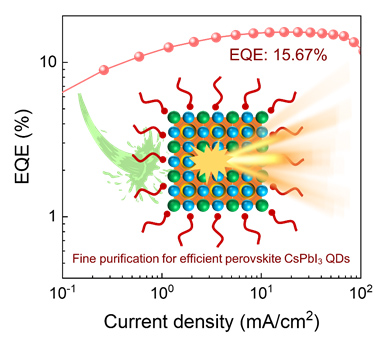| [1] |
Protesescu, L.; Yakunin, S.; Bodnarchuk, M.I.; Krieg, F.; Caputo, R.; Hendon, C.H.; Yang, R.X.; Walsh, A.; Kovalenko, M.V. Nano Lett. 2015, 15, 3692.
|
| [2] |
Zhang, F.; Zhong, H.; Chen, C.; Wu, X.-G.; Hu, X.; Huang, H.; Han, J.; Zou, B.; Dong, Y. ACS Nano 2015, 9, 4533.
|
| [3] |
Xu, L.; Li, J.; Cai, B.; Song, J.; Zhang, F.; Fang, T.; Zeng, H. Nat. Commun. 2020, 11, 3902.
|
| [4] |
Fang, T.; Zhang, F.; Yuan, S.; Zeng, H.; Song, J. InfoMat 2019, 1, 211.
|
| [5] |
Xu, L.; Yuan, S.; Zeng, H.; Song, J. Mater. Today Nano 2019, 6, 100036.
|
| [6] |
Song, J.; Li, J.; Xu, L.; Li, J.; Zhang, F.; Han, B.; Shan, Q.; Zeng, H. Adv. Mater. 2018, 30, 1800764.
|
| [7] |
Yang, Y.; Lin, F.; Zhu, C.; Chen, T.; Ma, S.; Luo, Y.; Zhu, L.; Guo, X. Acta Chim. Sinica 2020, 78, 217 . (in Chinese)
|
|
杨英, 林飞宇, 朱从潭, 陈甜, 马书鹏, 罗媛, 朱刘, 郭学益, 化学学报, 2020, 78, 217.
|
| [8] |
Song, J.; Xu, L.; Li, J.; Xue, J.; Dong, Y.; Li, X.; Zeng, H. Adv. Mater. 2016, 28, 4861.
|
| [9] |
Song, J.; Li, J.; Li, X.; Xu, L.; Dong, Y.; Zeng, H. Adv. Mater. 2015, 27, 7162.
|
| [10] |
Song, J.; Fang, T.; Li, J.; Xu, L.; Zhang, F.; Han, B.; Shan, Q.; Zeng, H. Adv. Mater. 2018, 30, 1805409.
|
| [11] |
Chiba, T.; Hayashi, Y.; Ebe, H.; Hoshi, K.; Sato, J.; Sato, S.; Pu, Y.-J.; Ohisa, S.; Kido, J. Nat. Photonics 2018, 12, 681.
|
| [12] |
Fang, T.; Wang, T.; Li, X.; Dong, Y.; Bai, S.; Song, J. Sci. Bull. 2020,
doi: https://doi.org/10.1016/j.scib.2020.08.023
|
| [13] |
Pan, J.; Quan, L.N.; Zhao, Y.; Peng, W.; Murali, B.; Sarmah, S.P.; Yuan, M.; Sinatra, L.; Alyami, N.M.; Liu, J. Adv. Mater. 2016, 28, 8718.
|
| [14] |
Dong, Y.; Wang, Y.-K.; Yuan, F.; Johnston, A.; Liu, Y.; Ma, D.; Choi, M.-J.; Chen, B.; Chekini, M.; Baek, S.-W. Nat. Nanotechnol. 2020, 15, 668.
|
| [15] |
Li, J.; Xu, L.; Wang, T.; Song, J.; Chen, J.; Xue, J.; Dong, Y.; Cai, B.; Shan, Q.; Han, B.; Zeng, H. Adv. Mater. 2017, 29, 1603885.
|
| [16] |
Hoshi, K.; Chiba, T.; Sato, J.; Hayashi, Y.; Takahashi, Y.; Ebe, H.; Ohisa, S.; Kido, J. ACS Appl. Mater. Interfaces 2018, 10, 24607.
|
| [17] |
Wang, Y.; Zhang, T.; Kan, M.; Zhao, Y. J. Am. Chem. Soc. 2018, 140, 12345.
|
| [18] |
Steele, J.A.; Jin, H.; Dovgaliuk, I.; Berger, R.F.; Braeckevelt, T.; Yuan, H.; Martin, C.; Solano, E.; Lejaeghere, K.; Rogge, S.M. Science 2019, 365, 679.
|
| [19] |
Wang, Y.; Dar, M.I.; Ono, L.K.; Zhang, T.; Kan, M.; Li, Y.; Zhang, L.; Wang, X.; Yang, Y.; Gao, X. Science 2019, 365, 591.
|
| [20] |
Swarnkar, A.; Marshall, A.R.; Sanehira, E.M.; Chernomordik, B.D.; Moore, D.T.; Christians, J.A.; Chakrabarti, T.; Luther, J.M. Science 2016, 354, 92.
|
| [21] |
Ling, X.; Zhou, S.; Yuan, J.; Shi, J.; Qian, Y.; Larson, B.W.; Zhao, Q.; Qin, C.; Li, F.; Shi, G. Adv. Energy Mater. 2019, 9, 1900721.
|
| [22] |
Pan, J.; Shang, Y.; Yin, J.; De Bastiani, M.; Peng, W.; Dursun, I.; Sinatra, L.; El-Zohry, A.M.; Hedhili, M.N.; Emwas, A.-H. J. Am. Chem. Soc. 2017, 140, 562.
|
| [23] |
Li, X.-L.; Cai, X.; Ali, M.U.; Su, S.-J.; Meng, H. J. Mater. Chem. C 2019, 7, 8063.
|
| [24] |
Acharya, K.P.; Titov, A.; Hyvonen, J.; Wang, C.; Tokarz, J.; Holloway, P.H. Nanoscale 2017, 9, 14451.
|
| [25] |
Tang, Z.; Tanaka, S.; Ito, S.; Ikeda, S.; Taguchi, K.; Minemoto, T. Nano Energy 2016, 21, 51.
|
| [26] |
Ikhmayies, S.J.; Ahmad-Bitar, R.N. Renew. Energ. 2013, 49, 143.
|
| [27] |
Li, J.; Chen, J.; Xu, L.; Liu, S.; Lan, S.; Li, X.; Song, J. Mater. Chem. Front. 2020, 4, 1444.
|
| [28] |
Lu, M.; Guo, J.; Sun, S.; Lu, P.; Wu, J.; Wang, Y.; Kershaw, S.V.; Yu, W.W.; Rogach, A.L.; Zhang, Y. Nano Lett. 2020, 20, 2829.
|
| [29] |
Shen, X.; Zhang, Y.; Kershaw, S.V.; Li, T.; Wang, C.; Zhang, X.; Wang, W.; Li, D.; Wang, Y.; Lu, M. Nano Lett. 2019, 19, 1552.
|
| [30] |
Zou, Y.; Yuan, Z.; Bai, S.; Gao, F.; Sun, B. Mater. Today Nano 2019, 5, 100028.
|
 )
)
 )
)
